Copyright ©2009 PopEntertainment.com. All rights reserved.
Posted:
July 3, 2009.
It seems everyday,
some controversy about the subway makes it in the papers, whether it's about
good new leadership or bad old leadership; whether it's about the list of
best trains or worst trains or about the rates going up. But of all the
events kicking up subway-related scuttlebutt, the recent release of a
reinvented The Taking of Pelham 1 2 3 stirred the least ire and gave
a lot of rears in the seats quite a ride as Denzel Washington's Walter
Garber – a tainted MTA executive – is forced to negotiate over the lives of
a subway car full of hostages with John Travolta's Ryder, a hard-assed
ex-con determined to score big time.
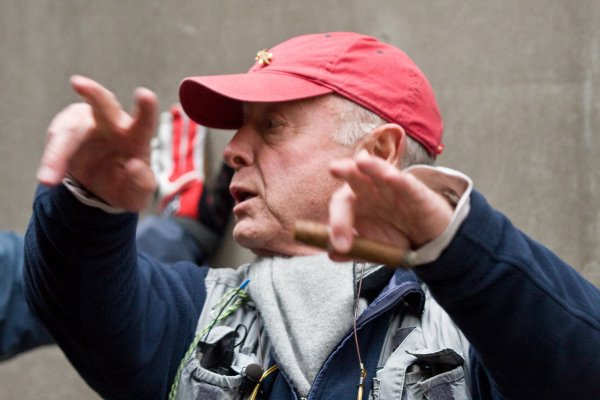 In covering this film,
a bunch of journos who got to speak with veteran British director Tony Scott
– he has made many movies including Top Gun, True Romance, Crimson Tide,
The Fan, Enemy of the State, Man on Fire and Domino – also got an
adventure of their own. Like experiencing an episode of Hidden New York, we
got to check out parts of the unused downtown subway system that only a very
few employees, some journalists and Scott's own researchers know about. So
in the course of seeing the film we got to see a part of New York that this
film helps to expose and learn a little about what it takes to shoot in this
uniquely New York environment – and boy is it musty and dusty...
In covering this film,
a bunch of journos who got to speak with veteran British director Tony Scott
– he has made many movies including Top Gun, True Romance, Crimson Tide,
The Fan, Enemy of the State, Man on Fire and Domino – also got an
adventure of their own. Like experiencing an episode of Hidden New York, we
got to check out parts of the unused downtown subway system that only a very
few employees, some journalists and Scott's own researchers know about. So
in the course of seeing the film we got to see a part of New York that this
film helps to expose and learn a little about what it takes to shoot in this
uniquely New York environment – and boy is it musty and dusty...
We did a tour of the
subways, and it was so dusty and moldy. I can't imagine spending months
filming down there.
I loved it down there. But I'm
from the northeast of England, which is depressed mining and shipbuilding,
so I grew up in this.
We rode on a #6 train. Did
you take it here? [laughs]
No. I went to 42nd Street to
check a print. I didn't take the train. Does Mayor Bloomberg still take the
train or not?
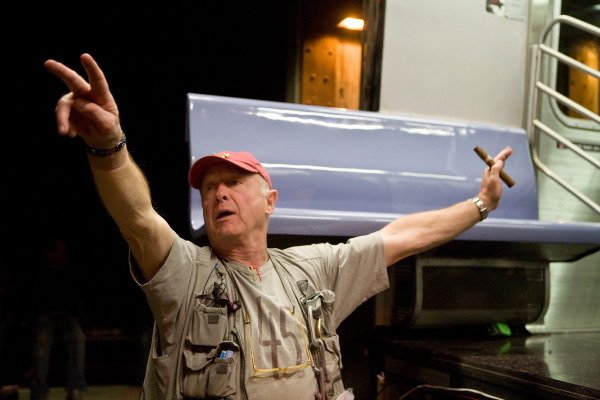 I understand he actually
takes a car to an express train that comes to City Hall.
I understand he actually
takes a car to an express train that comes to City Hall.
That's what motivated us to put
James Gandolifini on the train. That was the story. Research always drives
my movies.
You did a lot of research
for the film?
What always leads me in terms
of my movies are characters, so for 20 years now, I have a family – which I
call my "extended family" – and I send them out and say, "Here's the script,
go into the real world, cast these people in the real world, and find me
role models for my writers." So they go out in the real world and there's
this guy called Don. He got his start working in the DA's office, [so for]
Man on Fire, he spent six months in Mexico City and found real
bodyguards, a real mother, and a real kid. Then I reverse-engineer. I don't
change the structure of the script, but I use my research. That's always
been my mantra, and that's what gets me excited, because I get to educate
and entertain myself in terms of worlds I could never normally touch, other
than the fact that I'm a director. And I get paid well to do this, so it's
fun!
So what attracted you to the
original film? Why did you think it was ripe for a remake?
I don't regard it as a remake.
I don't regard it as a reinvention. My memory of the original was Walter
Matthau, with his laconic New York sense of humor, his pants at half-mast.
He was brilliant. It was really a very simplistic story: a million dollars
for hostages in a subway, and it was a hip location. Our story is motivated
by John's character, who's a real guy, and his character is motivated by
this real guy who just got out of jail before we started prepping the movie.
He wanted to take revenge and humiliate the state of New York like he had
been humiliated, because he worked for the city, and he lost his life for 12
years. So, he became the role model for John's character. You think about
that, and it's a very different motivation – revenge and humiliation. But
listen, I love the original. I could only watch ten minutes of it and then I
had to stop, because I wanted to leave that as a separate movie, and not
make this a reinvention or a remake.
How extensive was the
shooting in the NYC subway system?
It was all done here. We did
everything in New York. For the first time, I think, they gave us the
opportunity to use real toys and real trains in the subway. What we shot in
the motorman's booth with John Travolta was on stage, but everything else is
real. With the other movies, where you see them on subways, they make them
build sets. It's very hard to catch the real feel; you always sense there's
something not quite right, or something wrong. For instance, Money Train
was mostly done on stage in L.A. This was all done here with full-on
cooperation. I think they gave me full-on cooperation because the original
was one of New York's favorite movies.
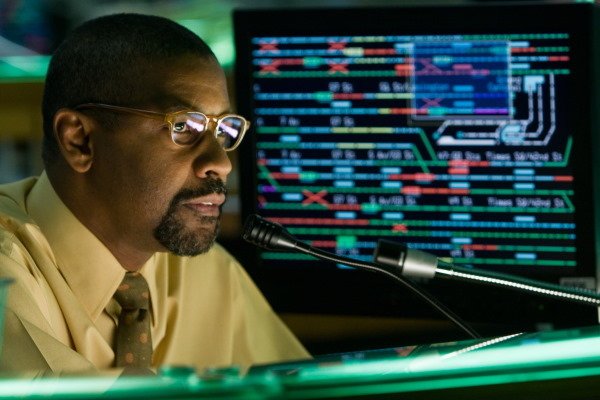 What was it like shooting in
the MTA's control room? They don't let anyone in there at all.
What was it like shooting in
the MTA's control room? They don't let anyone in there at all.
They let me in and it's like
NASA. I can't tell you where it is; otherwise I'll have to kill you! It was
difficult for us to get in there because of the security. Somebody could get
in there and target the subways. But the real MTA is like a NASA [control
room]. I went on a Sunday morning, and [there were] a hundred people there.
It's the size of a football field – three stories high – and you could hear
a pin drop. Everybody's on headsets, in suits, so I just took it right from
that. That's what we did in our movie. When you look at the original film, I
saw the original offices – which were just offices, really – and they had
taken a regular building and just constructed it for Walter Matthau and the
MTA with the graphics on the board. I had never shot on a subway before...
Actually, I did. The other time I shot on one was on my first film, The
Hunger. I shot very briefly with David Bowie on a subway. It was a
nightmare. We couldn't move anywhere with David Bowie there because he was
"David Bowie," so in the end I gave up. I stopped trying to attempt to shoot
the subway because all the freaks came out. But I think everybody's familiar
with what a subway looks and feels like because of television. I've given
the feeling that the subway's just different from what they've experienced
before, and I've made New York a very strong character in the movie. I keep
saying, "New York's a bad guy," because in John's character's terms, New
York is the guy who took away his life for twelve years.
Speaking of The Hunger,
did you know that David Bowie's son, Duncan Jones, had his film, Moon,
released the same time as yours?
Shit! I saw Duncan the other
day in L.A. I forgot he was David's son!
This is the fourth or fifth
time you've worked with Denzel Washington...
I'm about to do five, I hope. I
shouldn't have said that!
So what's it like working
with someone you've worked with so often? Do you guys have a shorthand and
does it make the day go by easier?
No! Our days are always hard.
There is a shorthand, but there's a terrible, old-fashioned word called
respect. I respect his process and he respects mine, and both of us are
insecure in that we're always examining and making what we do better, and my
goal every day is to try and think, "How do I see these characters in a
different way?" I'm always motivated by the characters, and it's the same
with Denzel. I mean you look at the four movies I've done with him, he's
always reached back inside himself and taken different aspects of his
personality from: Crimson Tide, Man on Fire, Déjà Vu and Pelham,
he's always given me a different Denzel. That's what I do with all my
actors. I tell them, "There's an aspect of you inside him, and I've got this
guy over here, and he fits that aspect of your personality." With Denzel,
he's always delivered. He's one of those actors who can do nothing and
communicate everything, and that comes from doing your homework. If you feel
comfortable about yourself, you don't have to give. You can just let the
camera sit and do nothing--and I rarely do, as the camera's always [moving].
Is the camera flying around
because you're antsy on the set, or you're specifically trying to do
something?
I've got ADD....
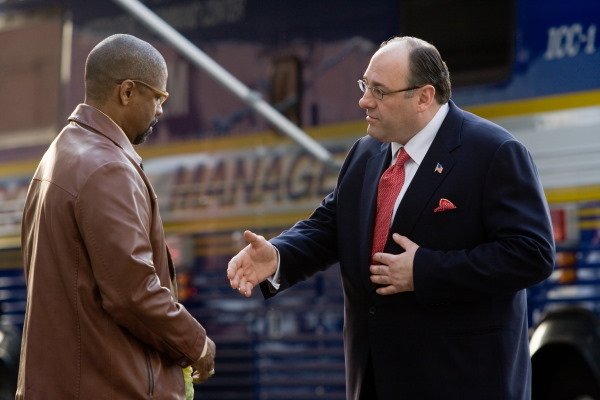 Take this example –
Gandolfini comes out of the subway after he first hears about the hijacking
and he's talking to his assistant. You do three or four swoops in a row.
Take this example –
Gandolfini comes out of the subway after he first hears about the hijacking
and he's talking to his assistant. You do three or four swoops in a row.
It's about energy and it's
about momentum. I think the movie's very exciting, and it's not one
individual thing. The true excitement comes from the actors. That gives you
the true drama – and whatever I can do with the camera, that's icing on the
cake. I wanted the movie to grab you. I use four cameras and I maybe do
three takes, so the actors love it. I had one camera which is just a steady
cam doing a 360, and three others on long lenses buried behind cars or trash
cans, so I got my coverage at the same time. I created movement with my
cameras to create momentum when I needed it. In the MTA room when we're
introducing Denzel – the cameras are moving slowly or not at all. In New
York, it was frenetic, and I stole from Koyaanisqatsi – that
time-lapse movie. I wanted New York to be the bad guy with this frenetic
anger, and I crossed that with the quiet interior. But as the film
progressed and the tension increased, [Gandolfini's] whirlwinding. Maybe I
move it more than I should, but that's the nature of the way I am. One of
the big challenges for this movie, and one of the reasons it's sort of
perverse why I took it on is in the original, it's really about two guys on
the telephone for two-thirds of the movie, and I said, "Damn! This is going
to be hard trying to keep it tense!" I was always seeing that tension, and
Brian gave me the tension on the pages, and the actors gave me the tension
in terms of their interplay.
You also have a strong
working relationship with James Gandolfini. He played such a mean bastard in
True Romance and in Crimson Tide, but here he's sort of a
bumbling mayor. Did he get any tips from Mayors Bloomberg or Guiliani?
No, he didn't. The person we
were looking at was Steve's dad, Steve Tisch, who was a construction
billionaire. That was our biggest point of reference. Gandolfini was such a
mean bastard in True Romance, but he is so unique because he's got
this sweetness, he's got this big heart, and he's dangerous. So he bounces
between both sides. In True Romance, what he did with Patricia
[beating the shit out of her], it broke his heart to have to punch her. But
you really felt it. It's the same with John Travolta. John's such a great
bad guy in this movie because you look in his eyes and you know he's got the
biggest heart. But he plays the other side. In his soul, he's just the
sweetest man. Jim's the same. They come out of a similar mold. Tony
Soprano's fantastic. But it was great that he pulled off the mayor, and got
away from Tony. He's charming and he's funny, and he's got these edges.
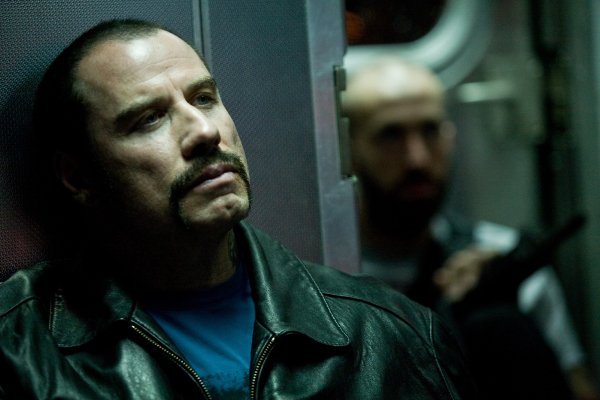 Travolta's performance is
completely over-the-top. How much of that came from him, and did you ever
think you could interchange Denzel's and Travolta's characters?
Travolta's performance is
completely over-the-top. How much of that came from him, and did you ever
think you could interchange Denzel's and Travolta's characters?
No way. They're total
opposites. Denzel said, "Let me play the bad guy!" He always wants to play
the bad guy. “I've had enough of playing cops and good guys. Let me play the
bad guy!" But with John, that's so much of the research I gave to John –
that's more in terms of the backstory, but the personality is John. I give
my actors a stack of tapes and research of the actual guys and I always look
back at my real characters. John's character's look came from a hitman for
The Craze, and another guy who just got out of jail had a Chicano mustache
and shaved head – and John's never shaved his head before. It's not about
being hip. It's about his commitment to the character. He lost a lot of
weight. He shaved his head. He made a full-on commitment to building the
character.
Did you and John talk about
how "big" he was going to go with this role?
When I saw "we talked," I sit
with these [actors] and we go to motels/hotels, and depending on how tough
the characters are – and how clandestine I've got to be – I take the
meeting, I transcribe them, and in those transcriptions are ideas or direct
words out of their mouths. Brian Helgeland, who's my partner-in-crime – the
writer – he and I did Man on Fire together, and he loves this process
of reaching in and touching the real world. Because for a writer, it's so
abstract to want to conjure up things, whereas if you can actually give them
things, you can say, "Here's a cigar. Examine that cigar, instead of
thinking of examining a cigar."
Since you've done four
movies with Denzel does one of you decide, "Okay, I'd like to do a movie
with Denzel," or is it the other way around? Did it feel like Ridley was
playing with your toys when he did
American Gangster with
Denzel?
I got jealous. I was like a
jilted lover! All you do is you read the script and I sent Don out – who's
my extended family – I sent Don out into the real world to give me ideas,
and I said, "It's Denzel." Denzel said, "I don't want to play another cop or
FBI agent," but I said, "We've got a great guy! And the guy in my mind who's
a role model is named Ike, and he's an Albanian, 65-year-old retired MTA
worker." He's the guy I stole from in terms of the 'guy next door', and the
personality traits.
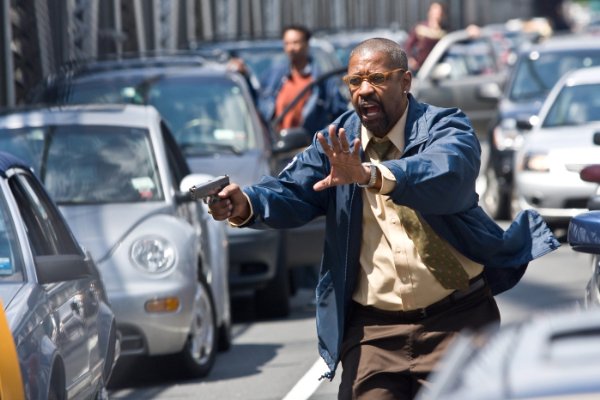 How do you work with your
brother Ridley?
How do you work with your
brother Ridley?
If Ridley and I worked together
on the set we'd kill each other. But we've been in business for 45 years
together, and when business is good in blood there's nothing better, but
rarely it's good. So we're right arm/left arm. And we've developed these
companies now – our commercial production company RSA, and we've got Scott
Free Productions. He's great. He's the nuts-and-bolts up at the front, and
I'm the day-to-day.
When Ridley was shooting
American Gangster, he said that when you're shooting the city is
impossible to control. Did you have that same experience?
I got lucky. Shooting in the
Waldorf Astoria was hard, because that sequence, they'd only let me shoot
six guns at a time, and each gun could only have six rounds in it. I had to
shoot all that shootout, and they wouldn't let me use automatic guns,
because you know they're scared in the city. Imagine staying at The Waldorf
Sunday morning, and hearing all that gunfire. I had a good experience here.
I had a few fingers thrown at me from cars going by. But other than that, it
was good. And the Manhattan Bridge, that was hard, with the helicopters and
the trains and the cars. We did it on Sunday, and I was respectful of the
times. I didn't run over. I had to cobble all that together to make it look
like – I stole from Bonnie and Clyde, and I actually stole it from
The Wild Bunch.
Speaking of style, you're
known for a distinctive editing technique with freeze-frames, jumbled
chronologies, slo-mo, etc. Domino was an extreme example.
If you look at Domino,
everything is driven by research. I hung out with these bounty hunters who
were all coked up all the time – they're all on speed or meth – and the
movie was a product of my research. My editor is Skip, and he's been with
me. He started cutting all my trailers, and he cuts the signature sequences
in my movies as well. And editor Chris Lebenzon started with me on Top
Gun. But everything in the way I shoot the movie is dictated by the
world when I touch it, so we had ride-alongs with bounty hunters who were
[sniffing like crazy] in the back, and it's a product of that. But I think I
was wrong. I didn't let the movie breathe enough. Richard Kelly wrote a
great script – and I got overcome by the insanity of the world I was
touching. I think I fucked up on that one.
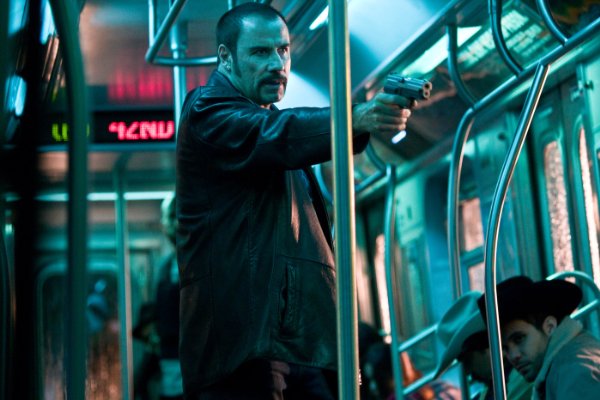 You mentioned Top Gun,
and in considering its enduring legacy, a lot of people have satirized
the homoerotic elements of it. Was that apparent while you were filming?
You mentioned Top Gun,
and in considering its enduring legacy, a lot of people have satirized
the homoerotic elements of it. Was that apparent while you were filming?
No it wasn’t. Not at all. But
Quentin [Tarantino] did that little cameo in that movie Sleep With Me,
and it was brilliant. He sent it to me and said, “Watch this, and don’t take
offense!” I had just done The Hunger, and Hollywood’s always trying
to find the new kid on the block, and nobody’s seen a foot of film. I was
actually developing Man on Fire 25 years ago, and they saw a cut of
The Hunger and all of a sudden my parking spot at Warner Brothers was
painted out! It took me four more years to get another movie, which was
Top Gun. Producer Don Simpson saw [The Hunger] while
channel-surfing at 3 a.m. I think he was high. He actually saw a Saab
commercial that I shot of a jet racing a car, then saw The Hunger. He
and Jerry [Bruckheimer] called me. Hollywood just hated that movie. They
called it, “Esoteric, artsy-fartsy,” and now we’re going to do a sequel to
The Hunger. I’m not directing it, but we’re doing it.
This is somewhat of a
remake, but how would you feel if someone redid, say, Top Gun?
I’d hate it. No, that was sort
of a knee-jerk reaction [laughs]. I'm controlling [The Hunger 2],
and it's gone to the next level. It's not a reinvention or a
reinterpretation. It ends up actually in Sao Paolo. It starts in New York
and ends up in Sao Paolo. It's a very different movie, but it springboards
off the original. We're writing it right now, we've got a great writer.
Actually The Hunger was a direct steal from a movie called
Performance. It is a brilliant movie. The Hunger was a total
knockoff of Performance. After I finished it, I called Nick [Roeg,
the director] and told him. [The sequel] is not a re-invention or a
re-interpretation. It ends up actually in Sao Paolo. It starts in New York
and ends up in Sao Paolo. It's a very different movie, but it springboards
off the original. We've got a great writer and we're writing it right now.
Email
us Let us
know what you
think.
Features
Return to the features page.